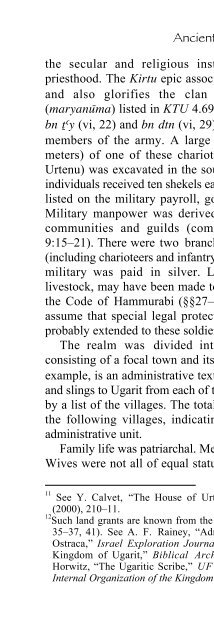A Primer on Ugaritic: Language, Culture, and Literature - enenuru
A Primer on Ugaritic: Language, Culture, and Literature - enenuru
A Primer on Ugaritic: Language, Culture, and Literature - enenuru
Create successful ePaper yourself
Turn your PDF publications into a flip-book with our unique Google optimized e-Paper software.
Ancient Ugarit 17<br />
the secular <strong>and</strong> religious instituti<strong>on</strong>s, particularly the high<br />
priesthood. The Kirtu epic associates the king with the clan of t{<br />
<strong>and</strong> also glorifies the clan of dtn. The chariot-warriors<br />
(maryanuäma) listed in KTU 4.69 include a group of priests called<br />
bn t{y (vi, 22) <strong>and</strong> bn dtn (vi, 29), who were am<strong>on</strong>g the well-paid<br />
members of the army. A large <strong>and</strong> wealthy home (200 square<br />
meters) of <strong>on</strong>e of these chariot-warriors (apparently known as<br />
Urtenu) was excavated in the southwest part of the city. 11 These<br />
individuals received ten shekels each <strong>and</strong> their family members, also<br />
listed <strong>on</strong> the military payroll, got four shekels each (vi, 23–24).<br />
Military manpower was derived from draft quotas taken from<br />
communities <strong>and</strong> guilds (compare Solom<strong>on</strong>’s corvee, 1 Kgs<br />
9:15–21). There were two branches of military service: the army<br />
(including charioteers <strong>and</strong> infantry) <strong>and</strong> the navy. The professi<strong>on</strong>al<br />
military was paid in silver. L<strong>and</strong> grants, including grants of<br />
livestock, may have been made to professi<strong>on</strong>al soldiers. Based <strong>on</strong><br />
the Code of Hammurabi (§§27–29, 31–32, 35–37, 41), we may<br />
assume that special legal protecti<strong>on</strong> over l<strong>and</strong> <strong>and</strong> property was<br />
probably extended to these soldiers. 12<br />
The realm was divided into administrative districts, each<br />
c<strong>on</strong>sisting of a focal town <strong>and</strong> its villages (gímrm). KTU 4.63, for<br />
example, is an administrative text recording the shipment of bows<br />
<strong>and</strong> slings to Ugarit from each of the towns. Each town is followed<br />
by a list of the villages. The totals are inclusive of the towns <strong>and</strong><br />
the following villages, indicating that together they formed an<br />
administrative unit.<br />
Family life was patriarchal. Men could have more than <strong>on</strong>e wife.<br />
Wives were not all of equal status. The “first” wife bore the title<br />
11<br />
See Y. Calvet, “The House of Urtenu,” Near Eastern Archaeologist 63<br />
(2000), 210–11.<br />
12<br />
Such l<strong>and</strong> grants are known from the Code of Hammurabi (§§27–29, 31–32,<br />
35–37, 41). See A. F. Rainey, “Administrati<strong>on</strong> in Ugarit <strong>and</strong> the Samaria<br />
Ostraca,” Israel Explorati<strong>on</strong> Journal 12 (1962), 62–63; <strong>and</strong>, Rainey, “The<br />
Kingdom of Ugarit,” Biblical Archaeologist 28, 4 (1965), 102–125; W.<br />
Horwitz, “The <strong>Ugaritic</strong> Scribe,” UF 11 (1979), 389–94; M. Heltzer, The<br />
Internal Organizati<strong>on</strong> of the Kingdom of Ugarit (Wiesbaden, 1982).


